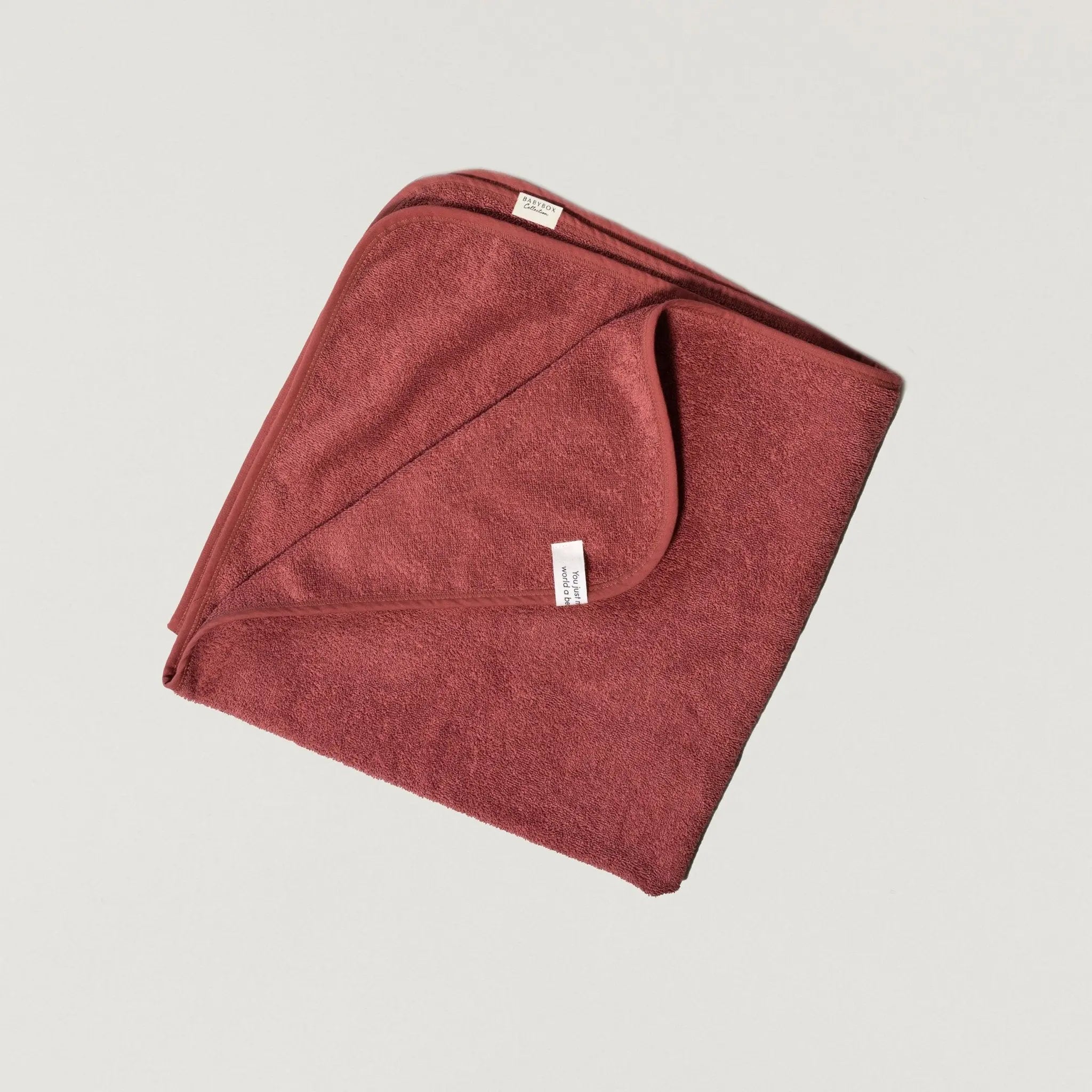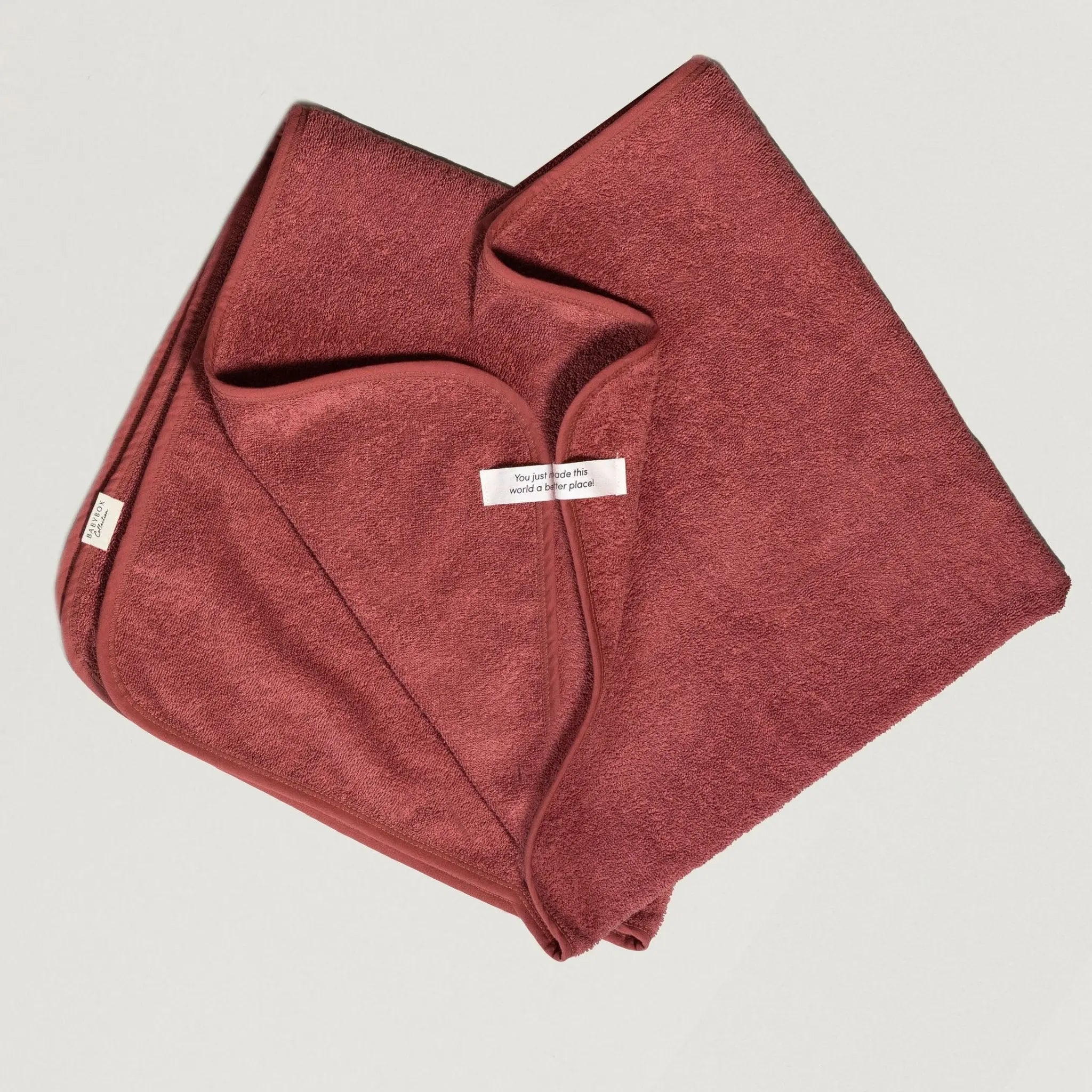







Babybox Collection
Babybox Birth Towel – Comfort from the Very First Moment
Give your baby comfort and security – from the very first second.
Babies spend around 40 weeks in the womb, surrounded by warmth, rhythm, and a soft reddish light.
This color tone – inspired by the natural hues of the female body – conveys closeness, calm, and safety.
Our Birth Towel captures exactly this feeling:
It wraps your newborn in a warm reddish tone, reminiscent of the color world of the womb – for a gentle, peaceful arrival in this new life.
Many midwives and medical professionals use similar color tones and dimmed lighting to help babies relax after birth and support a calm transition into the world.
Why parents love our Birth Towel
-
100% natural, GOTS-certified organic cotton – free from chemical dyes
-
Soft, reddish tone: inspired by the womb for a familiar sense of comfort
-
Perfect for the first moments: 70 × 70 cm – ideal for swaddling, later as a bath towel
-
Made with love: hanger with the message “You just made this world a better place!”
-
Sustainably designed: completely plastic-free supply chain
-
Includes birth card made from natural wood pulp paper – space for name, birth time, weight & zodiac sign
The gentler a baby’s arrival in this world, the calmer and more connected the beginning of life together will be.
That’s why we created the Babybox Birth Towel – inspired by comfort, made with love.
Material: 100% organic cotton (GOTS-certified)
Production: Turkey
Size: 70 × 70 cm
Care: Wash separately or with dark laundry before first use; slight color changes may occur.
Sustainability: No plastic used throughout the entire production process.
Developed by us for you – no plastic used throughout the entire supply chain.
To keep your birth towel soft, absorbent, and beautiful for a long time, we recommend gentle care. The delicate cotton fabric is natural and untreated – perfect for your baby’s sensitive skin, but also more delicate when exposed to friction or mechanical stress.
How to care for your towel:
-
Wash at max. 30 °C on a wool or delicate cycle.
-
Use a mild, enzyme-free detergent (for wool or silk) and avoid fabric softener.
-
Place the towel in a laundry bag to prevent pulled threads from zippers or Velcro.
-
Do not spin or tumble dry – instead, lay flat to air dry.
-
Do not iron – heat may damage the delicate weave.
Tip:
If small loops appear, gently pull them back to fabric level – this will not affect the towel’s quality or absorbency.
With proper care, your birth towel will stay beautifully soft – a loving companion for those precious first days with your baby.
* applies to deliveries within Germany, delivery times for other countries can be found under Payments & Shipment
True-to-original color
Developed by moms & midwives
100% organic cotton
Fair production
in Europe
FAQ
Yes, they can! A study conducted by researchers at the University of Sussex, led by Anna Franklin, explored how infants discern colors. Using a technique called novelty preference, the study involved showing babies familiar and new hues to measure their reactions. The findings revealed that babies can categorize five distinct color groups: red, yellow, green, blue, and purple. This suggests that infants have an inherent ability to differentiate colors, independent of language development. The study provides insights into how the human brain processes and categorizes color from an early age.
The study primarily focuses on babies aged four to six months. There is less information on newborns, but it is generally believed that their color perception is less developed than that of older infants. Newborns are likely able to recognize only strong contrasts and basic colors like black, white, and red. The ability to distinguish a broader spectrum of colors develops in the first few months of life.
Study from 1994 by Russell J. Adams*†, Mary L. Courage*, Michele E. Mercer*
Systematic measurement of human neonatal color vision
We used a new time-efficient method to evaluate chromatic-achromatic discrimination in newborn (n = 36) and 1-month-old (n = 34) human infants. Results showed that 74% of newtons discriminated a 10.5 × 17.5 deg broadband red patch from all relative luminances of an achromatic background, but only 14% of newborns did so with a blue, 36% with a green and 25% with a yellow patch. Most infants who “failed” did so at relative luminances very close to the respective photopic luminance match. At 1 month, performance improved somewhat although infants still show clear evidence of discriminating only the red patch. These results, the first to be obtained from individual newborns with a method incorporating a systematic variation of luminance, imply that early color vision is very limited. Possible photoreceptoral and neural bases for these immaturities are discussed.
National Libary of Medicine: Infant color perception: Insight into preceptual development
We recommend using the towel to wrap your baby in right after birth, as it is familiar with the color environment of the womb and studies have shown that it helps the baby transition more calmly into the new world. Of course, the towel is also perfect as a bath towel for the coming months and years.
Our producer recommended washing the towel at 30 degrees, which is why you’ll find this instruction on the care label. In our tests, we washed the towel at 60 degrees and then dried it in the dryer, and had good results. Just make sure to wash the towel with dark laundry, as it may cause discoloration.
Hebammen approved!
Was unsere Co-Founderin Sissi zum Geburtshandtuch sagt:


 Shop All
Shop All Bodys
Bodys Tops
Tops Pyjamas
Pyjamas Pants | Rompers & More
Pants | Rompers & More Tights | Socks
Tights | Socks Blankets | Sleeping Bags
Blankets | Sleeping Bags Jackets | Overalls
Jackets | Overalls Hats & More
Hats & More Baby Essentials
Baby Essentials Shoes
Shoes Furniture & Nursery Essentials
Furniture & Nursery Essentials Product Care
Product Care New In
New In Shop All
Shop All Mom Gift Boxes
Mom Gift Boxes Babyboxes & Mom Gift Boxes
Babyboxes & Mom Gift Boxes Gift Vouchers
Gift Vouchers Basic Deal
Basic Deal





